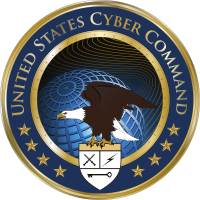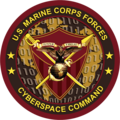United States Cyber Command
|
United States Cyber Command |
|
|---|---|
|
USCYBERCOM emblem |
|
| Lineup | May 21, 2010 |
| Country | United States of America |
| Armed forces | United States Armed Forces |
| Armed forces | (comprehensive) |
| Insinuation | United States Department of Defense |
| Fort George G. Meade | Anne Arundel County , MD |
| Commander, United States Cyber Command (DIRNSA) | |
|
Commander, US Cyber Command, Director, National Security Agency / Central Security Service |
|
The United States Cyber Command or USCYBERCOM is a US military authority and one of the eleven Unified Combatant Command . The US Cyber Command is entrusted with the electronic warfare , cyberwar and internet security of the US military . Since January 29, 2010 the command of the 10th US Fleet (Fleet Cyber Command) in Fort Meade , which was active until the end of the Second World War and was disbanded in June 1945.
History and context
chronology
The agency was activated in May 2010 as a functional command of the United States Strategic Command (STRATCOM) and began its full service in October 2010. It is regularly run by the director of the National Security Agency .
Until the first decade of the 21st century, Internet warfare played a niche role within the US armed forces in terms of both doctrinal importance and career orientation .
Due to legal provisions and traditional security dynamics, the security policy of the United States is subject to a regular review. These include the Quadrennial Defense Review (QDR), held every four years, in which the United States Department of Defense subjects itself to a defense policy assessment. The QDR, published in 2006, exposed a persistent inability of the Department of Defense to effectively and efficiently use the resources it had held for decades. The QDR 2006 therefore made cyber defense a priority in terms of security policy and recommended that the Ministry of Defense bundle and streamline its resources in terms of concept, organization and finance. The Ministry of Defense responded to the demand for an improved concept with the publication of the National Military Strategy for Cyberspace Operations , initially kept secret , which defined cyberspace for the entire armed forces for the first time. The Ministry's definition contradicted the definition of the US Air Force , which had assumed a relative leadership role in the previously decentralized development of cyber defense capacities.
On August 18, 2017, US President Donald Trump ordered the Cyber Command to be outsourced from STRATCOM and to be set up as another Unified Combatant Command in the future . This process has since been led by the Department of Defense . This process was completed on May 4, 2018.
Security policy context
The importance of cybersecurity has fundamentally increased in importance for the security policy of the United States since the end of the Cold War . Two trends stand out in particular. These include the increasing dependence of the United States, in particular that of its armed forces, on telecommunications networks on the one hand and a constant quantitative and qualitative increase in attacks on elements of its networked infrastructure that are important for security policy on the other.
The armed forces of the United States are very interconnected, affecting almost every aspect of their operations. This includes the management, supply and supervision of the armed forces in a global framework and real-time reconnaissance. As of autumn 2010, these tasks were performed by an infrastructure consisting of almost seven million networked devices, which was divided into around 15,000 networks and looked after by around 90,000 people. (See also Network-Centric Warfare )
assignment
The Cyber Command website represents the institution's mission as follows:
"USCYBERCOM plans, coordinates, integrates, synchronizes and conducts activities to: direct the operations and defense of the specified Department of Defense information networks and; prepare to, and when directed, conduct full spectrum military cyberspace operations in order to enable actions in all domains, ensure US / Allied freedom of action in cyberspace and deny the same to our adversaries. "
USCYBERCOM's range of assignments essentially comprises three goals, which serve to enforce both security and defense interests. First, the command ensures the day-to-day protection of the US defense infrastructure and advises associations of the armed forces on the implementation of their own tasks, for example in the electronic fight against terrorism . Second, the Cyber Command oversees all resources available to the military in cyber war in order to allocate them if necessary. Third, the command advises civil government agencies, especially the United States Department of Homeland Security , and institutions of allied states.
The nature and scope of the tasks that are derived from this three-part order are subject to confidentiality.
In 2010, Mark Young complained that the Cyber Command did not sufficiently exhaust the doctrinal scope of its possibilities.
structure
In order to anchor operational competencies in the four regular armed forces of the US military that relate to cyber warfare, the Cyber Command is divided into four corresponding sub-commands, similar to other command structures:
Army Forces Cyber Command
The Army (USA) is involved with the Second Army through the Army Forces Cyber Command (ARCYBER) . The following units are bound under it for cyber combat :
-
Army Network Enterprise Technology Command , as well as 9th Army Signal Command
- Cyber Protection Brigade
- United States Army Intelligence and Security Command
- 1st Information Operations Command
- 780th Military Intelligence Brigade
Fleet Cyber Command
The Navy (USN) is represented by Fleet Cyber Command / Tenth Fleet (US 10th Fleet) . It includes the following units for electronic warfare:
- Naval Network Warfare Command
- Navy Cyber Defense Operations Command
- Naval Information Operation Commands
- Combined Task Forces
Air Forces Cyber Command
The Air Force (USAF) is represented by the Air Forces Cyber Command (AFCYBER) with the Twenty Fourth Air Force (24th US Air Force) . The following units specialize in electronic warfare:
Marine Corps Forces Cyberspace Command
The Marines (USMC) is the Marine Corps Forces Cyberspace Command represented.
guide
Commanders
| No. | Surname | image | Beginning of the appointment | End of appointment |
|---|---|---|---|---|
| 3 | Gen Paul M. Nakasone (USA) |

|
5th May 2018 | --- |
| 2 | Adm Michael S. Rogers (USN) |

|
April 2, 2014 | 4th May 2018 |
| interim | LtGen Jon M. Davis (USMC) |

|
March 29, 2014 | April 2, 2014 |
| 1 | Gene Keith B. Alexander (USA) |

|
May 21, 2010 | March 28, 2014 |
coat of arms
The 32 alphanumeric characters in the emblem "9ec4c12949a4f31474f299058ce2b22a" are the MD5 hash value that results from the text of the mission objective above.
See also
- Cyber and information space command in Germany
- Command, command support and cyber defense in Austria
literature
- William J. Lynn: Defending a New Domain: The Pentagon's Cyberstrategy. In: Foreign Affairs . Volume 89, Number 5, September / October 2010, pp. 97-108. (English)
- Robert L. Ramsden: What and Where? Considerations for Command and Control of Cyberspace Operations. (PDF; 482 kB) 2010. (English)
Web links
- Official website of USCYBERCOM (English)
- US Department of Defense USCYBERCOM data sheet , (English, PDF; 124 kB), May 25, 2010 (meanwhile replaced by a revised document)
- National Military Strategy for Cyberspace Operations (English)
- Matthias Rüb: Digital cruise missiles. America's fight against hackers. In: Frankfurter Allgemeine Zeitung . July 21, 2011, accessed July 21, 2011 (On the US Strategy against Attacks on Security-Related Networks).
Individual evidence
- ↑ a b Companies and States in Cyber War. In: Frankfurter Allgemeine Zeitung . October 12, 2010, accessed October 12, 2010 .
- ↑ a b cf. Ali, Rizwan: Cyberpower and National Security (Review) , in: Air Force Research Institute , February 22, 2011. Retrieved March 12, 2011.
- ↑ Schachtman, Noah: 26 Years After Gibson, Pentagon Defines 'Cyberspace' , in Wired.com , Danger Room , May 23, 2008. Retrieved March 12, 2011 /
- ^ Statement by President Donald J. Trump on the Elevation of Cyber Command. The White House, Office of the Press Secretary , August 26, 2017, accessed August 26, 2017 .
- ↑ Jim Garamone, Lisa Ferdinando: DoD Initiates Process to Elevate US Cyber Command to Unified Combatant Command. DoD News, August 18, 2017, accessed August 26, 2017 .
- ↑ Katie Lange: Cybercom Becomes DoD's 10th Unified Combatant Command. (No longer available online.) May 3, 2018, formerly in the original ; accessed on February 15, 2019 . ( Page no longer available , search in web archives )
- ^ Lynn III, William J .: Defending a New Domain: The Pentagon's Cyberstrategy. In: Foreign Affairs , Volume 89, Number 5, September / October 2010, p. 98.
- ↑ US Department of Defense, Cyber Command Fact Sheet, May 21, 2010 Archived copy ( February 9, 2014 memento in the Internet Archive )
- ^ Lynn III, William J .: Defending a New Domain: The Pentagon's Cyberstrategy. In: Foreign Affairs , Volume 89, Number 5, September / October 2010, p. 102.
- ↑ cf. Young, Mark D .: National Cyber Doctrine: The Missing Link in the Application of American Cyber Power (PDF; 124 kB), in: Journal of National Security Law and Policy , Vol. 4, No. 173.
- ^ Pauline Jelinek: A code you can hack: On CYBERCOM's logo , Marine Corps Times . July 8, 2010. Archived from the original on July 15, 2010.





